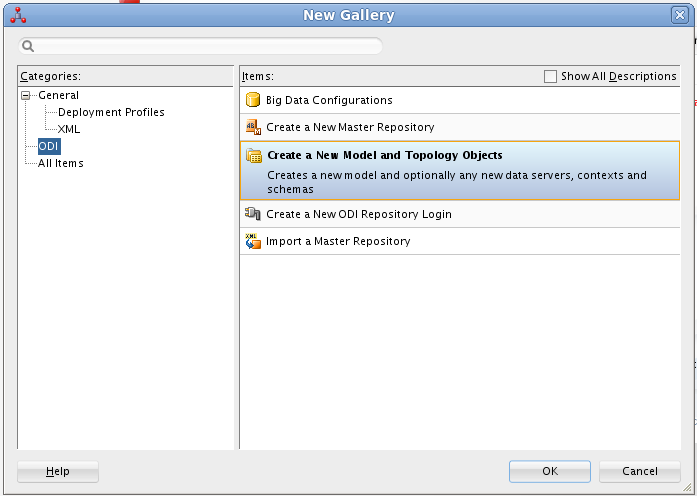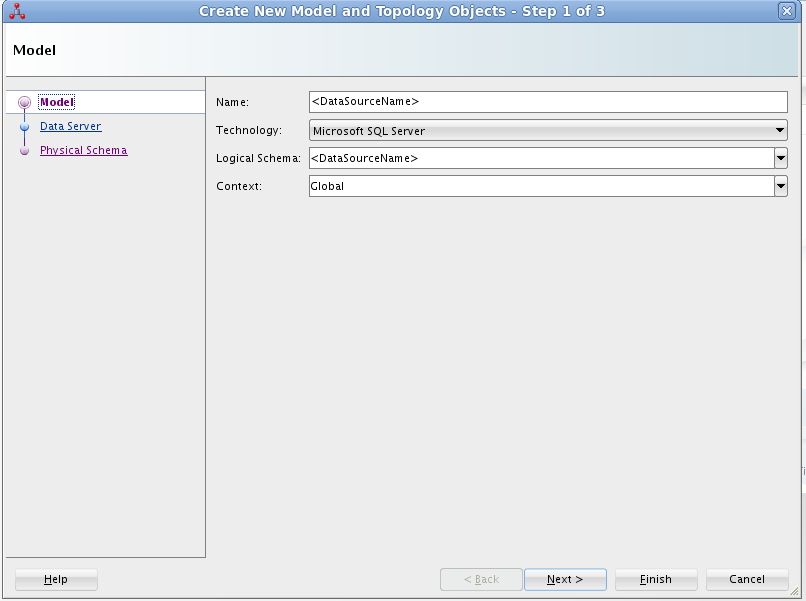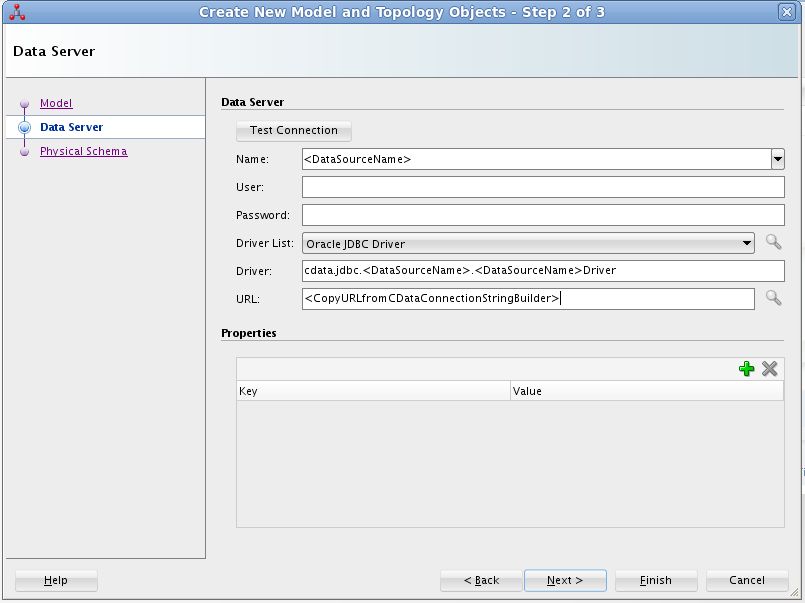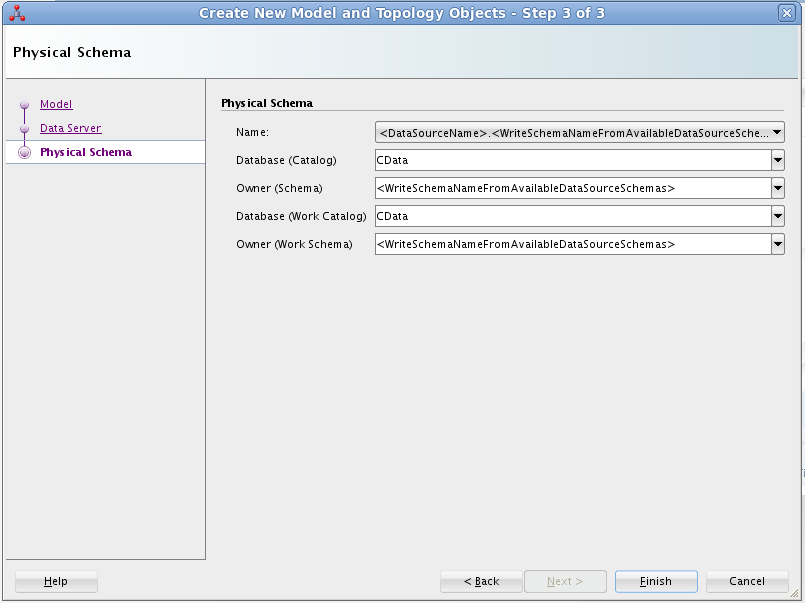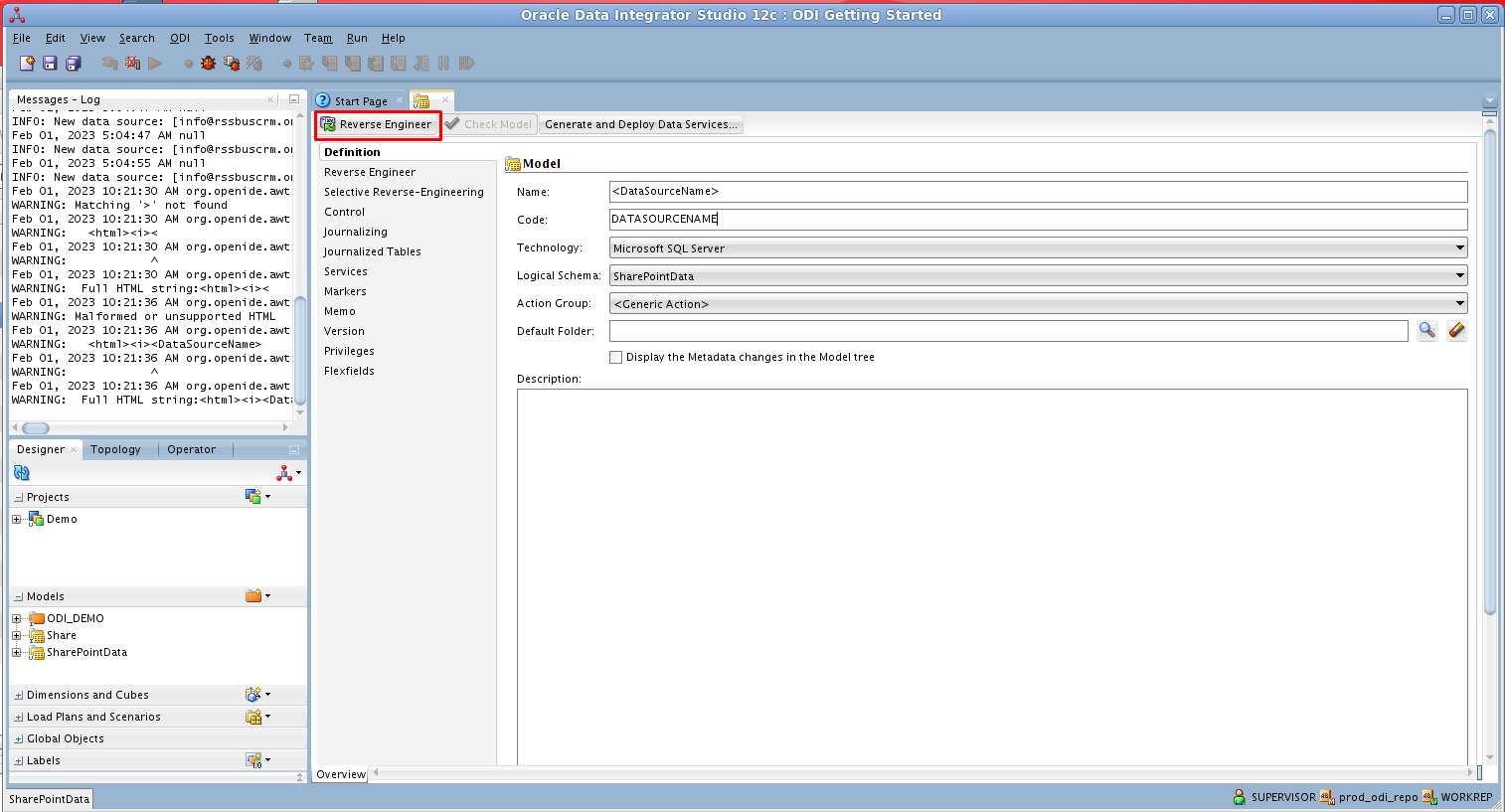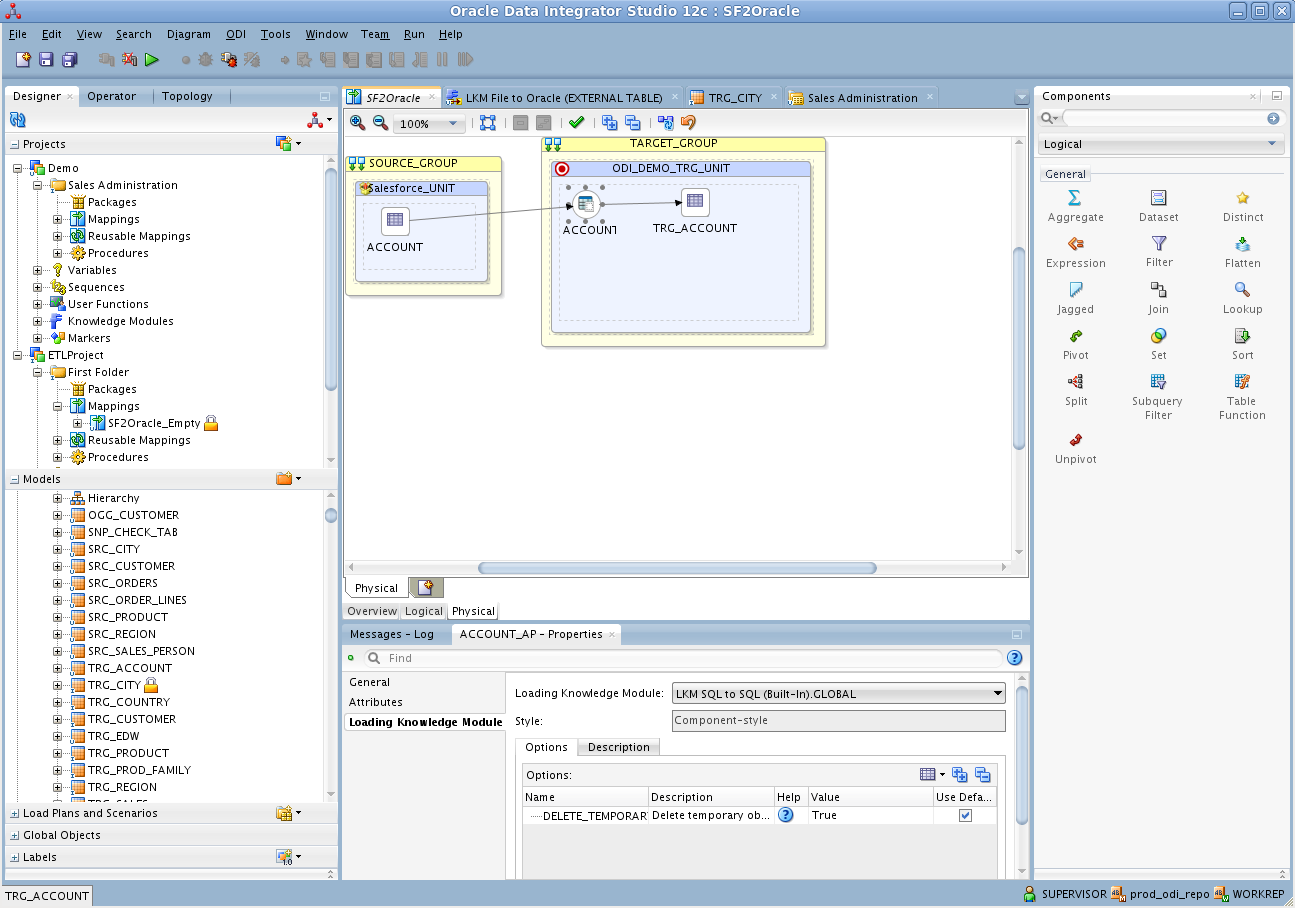Discover how a bimodal integration strategy can address the major data management challenges facing your organization today.
Get the Report →ETL JSON in Oracle Data Integrator
This article shows how to transfer JSON services into a data warehouse using Oracle Data Integrator.
Leverage existing skills by using the JDBC standard to read and write to JSON: Through drop-in integration into ETL tools like Oracle Data Integrator (ODI), the CData JDBC Driver for JSON connects real-time JSON services to your data warehouse, business intelligence, and Big Data technologies.
JDBC connectivity enables you to work with JSON just as you would any other database in ODI. As with an RDBMS, you can use the driver to connect directly to the JSON APIs in real time instead of working with flat files.
This article walks through a JDBC-based ETL -- JSON to Oracle. After reverse engineering a data model of JSON entities, you will create a mapping and select a data loading strategy -- since the driver supports SQL-92, this last step can easily be accomplished by selecting the built-in SQL to SQL Loading Knowledge Module.
Install the Driver
To install the driver, copy the driver JAR (cdata.jdbc.json.jar) and .lic file (cdata.jdbc.json.lic), located in the installation folder, into the ODI appropriate directory:
- UNIX/Linux without Agent: ~/.odi/oracledi/userlib
- UNIX/Linux with Agent: ~/.odi/oracledi/userlib and $ODI_HOME/odi/agent/lib
- Windows without Agent: %APPDATA%\Roaming\odi\oracledi\userlib
- Windows with Agent: %APPDATA%\odi\oracledi\userlib and %APPDATA%\odi\agent\lib
Restart ODI to complete the installation.
Reverse Engineer a Model
Reverse engineering the model retrieves metadata about the driver's relational view of JSON services. After reverse engineering, you can query real-time JSON services and create mappings based on JSON tables.
-
In ODI, connect to your repository and click New -> Model and Topology Objects.
![Create a New Model]()
- On the Model screen of the resulting dialog, enter the following information:
- Name: Enter JSON.
- Technology: Select Generic SQL (for ODI Version 12.2+, select Microsoft SQL Server).
- Logical Schema: Enter JSON.
- Context: Select Global.
![Configuring the Model]()
- On the Data Server screen of the resulting dialog, enter the following information:
- Name: Enter JSON.
- Driver List: Select Oracle JDBC Driver.
- Driver: Enter cdata.jdbc.json.JSONDriver
- URL: Enter the JDBC URL containing the connection string.
See the Getting Started chapter in the data provider documentation to authenticate to your data source: The data provider models JSON APIs as bidirectional database tables and JSON files as read-only views (local files, files stored on popular cloud services, and FTP servers). The major authentication schemes are supported, including HTTP Basic, Digest, NTLM, OAuth, and FTP. See the Getting Started chapter in the data provider documentation for authentication guides.
After setting the URI and providing any authentication values, set DataModel to more closely match the data representation to the structure of your data.
The DataModel property is the controlling property over how your data is represented into tables and toggles the following basic configurations.
- Document (default): Model a top-level, document view of your JSON data. The data provider returns nested elements as aggregates of data.
- FlattenedDocuments: Implicitly join nested documents and their parents into a single table.
- Relational: Return individual, related tables from hierarchical data. The tables contain a primary key and a foreign key that links to the parent document.
See the Modeling JSON Data chapter for more information on configuring the relational representation. You will also find the sample data used in the following examples. The data includes entries for people, the cars they own, and various maintenance services performed on those cars.
Built-in Connection String Designer
For assistance in constructing the JDBC URL, use the connection string designer built into the JSON JDBC Driver. Either double-click the JAR file or execute the jar file from the command-line.
java -jar cdata.jdbc.json.jarFill in the connection properties and copy the connection string to the clipboard.
![Using the built-in connection string designer to generate a JDBC URL (Salesforce is shown.)]()
Below is a typical connection string:
jdbc:json:URI=C:/people.json;DataModel=Relational;
![Configuring the Data Server]()
- On the Physical Schema screen, enter the following information:
- Name: Select from the Drop Down menu.
- Database (Catalog): Enter CData.
- Owner (Schema): If you select a Schema for JSON, enter the Schema selected, otherwise enter JSON.
- Database (Work Catalog): Enter CData.
- Owner (Work Schema): If you select a Schema for JSON, enter the Schema selected, otherwise enter JSON.
![Configuring the Physical Schema]()
- In the opened model click Reverse Engineer to retrieve the metadata for JSON tables.
![Reverse Engineer the Model]()
Edit and Save JSON Services
After reverse engineering you can now work with JSON services in ODI.
To edit and save JSON services, expand the Models accordion in the Designer navigator, right-click a table, and click Data. Click Refresh to pick up any changes to the data. Click Save Changes when you are finished making changes.
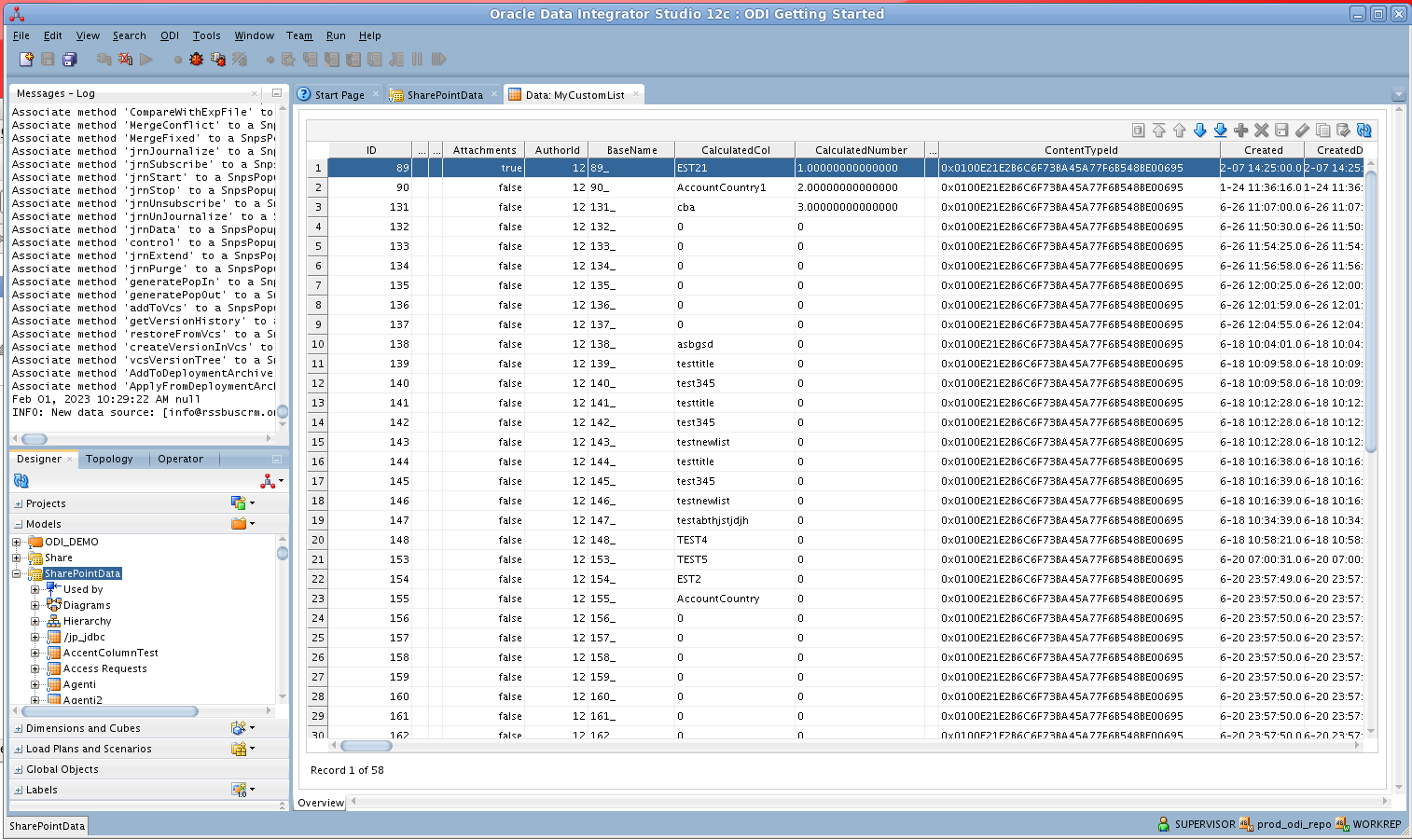
Create an ETL Project
Follow the steps below to create an ETL from JSON. You will load people entities into the sample data warehouse included in the ODI Getting Started VM.
Open SQL Developer and connect to your Oracle database. Right-click the node for your database in the Connections pane and click new SQL Worksheet.
Alternatively you can use SQLPlus. From a command prompt enter the following:
sqlplus / as sysdba- Enter the following query to create a new target table in the sample data warehouse, which is in the ODI_DEMO schema. The following query defines a few columns that match the people table in JSON:
CREATE TABLE ODI_DEMO.TRG_PEOPLE ([ PERSONAL.NAME.LAST ] NUMBER(20,0),[ personal.name.first ] VARCHAR2(255)); - In ODI expand the Models accordion in the Designer navigator and double-click the Sales Administration node in the ODI_DEMO folder. The model is opened in the Model Editor.
- Click Reverse Engineer. The TRG_PEOPLE table is added to the model.
- Right-click the Mappings node in your project and click New Mapping. Enter a name for the mapping and clear the Create Empty Dataset option. The Mapping Editor is displayed.
- Drag the TRG_PEOPLE table from the Sales Administration model onto the mapping.
- Drag the people table from the JSON model onto the mapping.
- Click the source connector point and drag to the target connector point. The Attribute Matching dialog is displayed. For this example, use the default options. The target expressions are then displayed in the properties for the target columns.
- Open the Physical tab of the Mapping Editor and click PEOPLE_AP in TARGET_GROUP.
- In the PEOPLE_AP properties, select LKM SQL to SQL (Built-In) on the Loading Knowledge Module tab.
![SQL-based access to JSON enables you to use standard database-to-database knowledge modules.]()
You can then run the mapping to load JSON services into Oracle.






